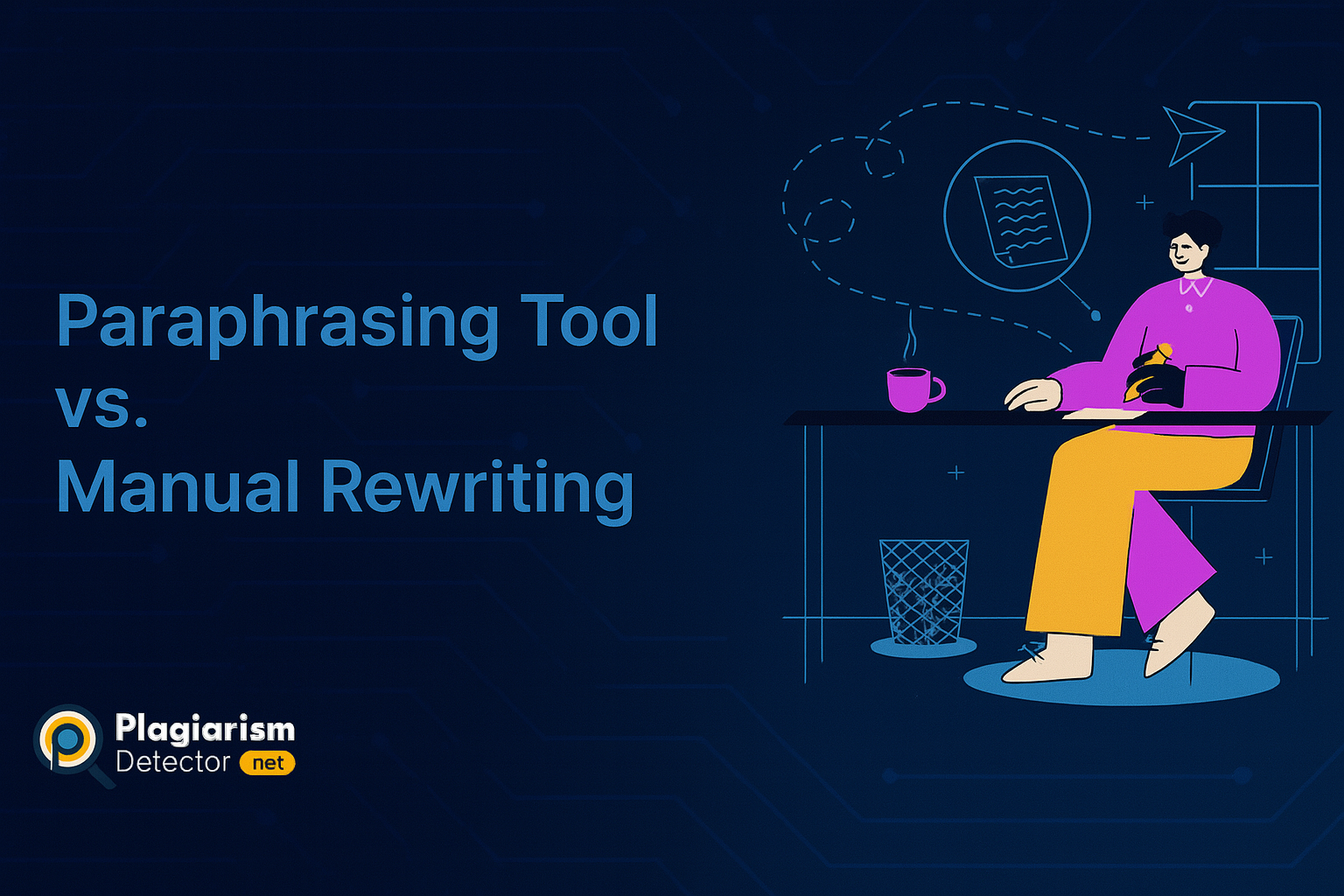
Have you ever wondered why, as the world shifts to automation, writers don’t also claim their part? Sometimes, especially for me, staring at a blank document to think of new ways to rewrite something already published feels overwhelming.
In these cases, a paraphrasing tool becomes a real lifesaver. But sometimes my colleagues question if paraphrasing tools outperform humans.
So, I’ve outlined the main differences between them to show how these tools can help you work more efficiently.
Understanding Manual Rewriting
Rewriting by hand involves taking existing content and changing it into something new while keeping the original meaning. To do this well, you need to understand the text, have a good vocabulary, and pay attention to detail. It’s not just about replacing words; it’s about changing the structure and style to make the writing sound natural and interesting.
So, how do you rephrase an article effectively? First, read the original text carefully. Understand its main ideas, then express them in your own words.
Before you start, ask yourself: Why am I rewriting this article? Who is it for? Knowing these things helps you adjust the content to fit the situation and keep the message clear.
Benefits of Manual Rewriting
Make sure your words match who you’re talking to.
Come up with fresh ideas to keep readers interested.
Look at data to make your message clear and strong.
Use your own words to stay honest and original.
Get better at writing by practicing a lot.
Change how you write based on the situation.
Tweak sentences to make them easier to read.
Drawbacks of Manual Rewriting
The process is time-intensive.
Demands advanced writing abilities and a broad vocabulary.
Style may lack consistency.
Increased risk of fatigue and mistakes.
Subtle meanings in the original text may be overlooked.
Role of Paraphrasing Tools
A tool for paraphrasing helps by automating the task of rewriting. Rather than spending a lot of time rewording, you can use AI to change your content quickly. So, I think it’s perfect when you need to handle lengthy texts or face tight deadlines.
How does it work?
It looks at your initial content, examines it, and then crafts a new version with altered words and sentence patterns. The main idea, though, stays intact.
The best part?
These tools rely on algorithms and AI to assist you in rephrasing your sentences and phrases effectively.
As a result, you no longer need to spend hours manually tweaking each sentence. It’s crucial to understand that today’s AI tools can grasp context and deliver precise outcomes, ensuring you achieve clarity without losing quality. Simply put, they help you polish your work and eliminate writing mistakes.
Benefits of Paraphrasing Tools
Efficiently rephrases extensive text segments.
Clarifies complex sentences to enhance comprehension.
Enables tone adjustments tailored to the target audience.
Reduces grammatical errors in rewritten material.
Ensures stylistic consistency across content.
Provides alternative phrasings and fresh insights.
Produces original content through structural and lexical variation.
Drawbacks of Paraphrasing Tools
Lacks deep contextual understanding.
May produce phrasing that feels unnatural or awkward.
Can fail to convey subtle nuances.
Encourages reliance on technology for written communication.
Output quality is inconsistent across tools.
Difference Between a Paraphrasing Tool and Manual Rewriting
Many writers, like you, might ask how using a paraphrasing tool is different from rewriting by hand, correct?
Firstly, let’s discuss paraphrasing tools.
A tool for paraphrasing uses smart algorithms to quickly change text while keeping its meaning. This helps you write efficiently and consistently.
AI looks for important words, context, and grammar so it can change your text but keep the original meaning. These tools are great when you have big files and need to work fast.
Now moving on to manual rewriting
Reworking content by hand means diving in yourself. You need to look at, get, and then change the content in your own words. A tool can help speed things up. This lets you shape the words, feel, and look, which is great for creative works.
Yet, it needs time and attention, more so if it’s long. A typical person might redo 1,000 words in an hour. It does bring top-notch results, but it can be tiring, especially when juggling several tasks at once.
Paraphrasing Tool vs. Manual Rewriting: Which One is Better for You?
Deciding whether to use a paraphrasing tool or rewrite manually depends on your objectives and how much time you have. If you’re after speed, a paraphrasing tool is beneficial. It quickly rewords content, ensuring accuracy and consistency.
Research indicates these AI tools can boost writing efficiency by up to 60%, which is quite impressive. This rapid process helps busy professionals, students, and anyone with limited time, allowing them to focus on more important tasks instead of spending hours rewriting.
Manual rewriting is better for making detailed changes. It lets you choose every word, which is helpful for specialized areas or creative projects needing a specific tone.
However, it can be time-consuming, especially with lengthy or complicated texts, and it requires a lot of mental effort. Therefore, for me, it’s not always practical for everyday tasks.
Overall, a paraphrasing tool generally excels over manual rewriting by offering speed, precision, and readability. These AI tools also often improve phrase optimization for search engines, enhancing visibility on platforms like Google.
This SEO advantage makes paraphrasing tools especially useful for online writing. They naturally incorporate keywords and increase text relevance. So, in my view, for quality and convenience in your daily writing, using a paraphrasing tool is a smart choice.
Conclusion
To sum up, tools for paraphrasing provide quickness, precision, and advantages for SEO, making them perfect for everyday tasks. While manual rewriting offers creativity and subtlety, a tool is often more practical and efficient for most writing purposes.
